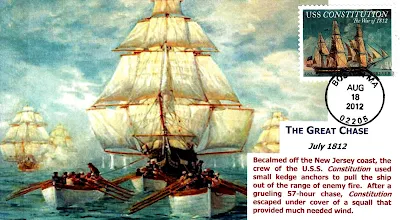USPS from 2012 till 2015 issued for stamps to commemorate the 200th anniversary of the War of 1812-1815. These single first day cover stamps depicted The Defense of Ft. McHenry, The Great Chase of the U.S.S. Constitution, The Battle of Lake Erie and The Battle of New Orleans. Cancellation postmarks originated in the places of the battle sites.
THE GREAT CHASE
In July 1812, while becalmed off the New Jersey coast, the crew of the U.S.S. Constitution used small kedge anchors to pull the ship out of the range of enemy fire. After a grueling 57-hour chase, the Constitution escaped under cover of a squall that provided much needed wind.
THE GREAT CHASE
In July 1812, while becalmed off the New Jersey coast, the crew of the U.S.S. Constitution used small kedge anchors to pull the ship out of the range of enemy fire. After a grueling 57-hour chase, the Constitution escaped under cover of a squall that provided much needed wind.
The Constitution is most noted for her actions during the War of 1812 against the United Kingdom, when she captured numerous merchant ships and defeated five smaller British warships: HMS Guerriere, Java, Pictou, Cyane, and Levant. The battle with Guerriere earned her the nickname "Old Ironsides" and public adoration that has repeatedly saved her from scrapping. She continued to serve as flagship in the Mediterranean and African squadrons, and she circled the world in the 1840s. During the American Civil War, she served as a training ship for the United States Naval Academy. She carried American artwork and industrial displays to the Paris Exposition of 1878.
The Constitution was retired from active service in 1881 and served as a receiving ship until being designated a museum ship in 1907. In 1934, she completed a three-year, 90-port tour of the nation. She sailed under her own power for her 200th birthday in 1997, and again in August 2012 to commemorate the 200th anniversary of her victory over Guerriere.
BATTLE OF LAKE ERIE
On 10 September 1813, after taking command of the U.S. Brig Niagara, Admiral Perry opened fire on the British line, striking the H.M.S. Queen Charlotte and the H.M.S. Detroit. After several additional broadsides, the entire British fleet surrendered.
The Constitution was retired from active service in 1881 and served as a receiving ship until being designated a museum ship in 1907. In 1934, she completed a three-year, 90-port tour of the nation. She sailed under her own power for her 200th birthday in 1997, and again in August 2012 to commemorate the 200th anniversary of her victory over Guerriere.
BATTLE OF LAKE ERIE
On 10 September 1813, after taking command of the U.S. Brig Niagara, Admiral Perry opened fire on the British line, striking the H.M.S. Queen Charlotte and the H.M.S. Detroit. After several additional broadsides, the entire British fleet surrendered.
THE DEFENSE OF FORT MCHENRY
Beginning at 6:00a.m. on 13 September 1814, British warships under the command of Vice Admiral Alexander Cochrane continuously bombarded Fort McHenry with rockets and mortars for more than 25 hours. Due to the poor accuracy of the British weapons at maximum range, and the limited range of the American guns, very little damage was done on either side before the British ceased their attack on the morning of 14th September. This assault was the inspiration for Francis Scott Key's lyric to the song "Star-Spangled Banner" which in 1931 became the official national anthem of the United States.
Beginning at 6:00a.m. on 13 September 1814, British warships under the command of Vice Admiral Alexander Cochrane continuously bombarded Fort McHenry with rockets and mortars for more than 25 hours. Due to the poor accuracy of the British weapons at maximum range, and the limited range of the American guns, very little damage was done on either side before the British ceased their attack on the morning of 14th September. This assault was the inspiration for Francis Scott Key's lyric to the song "Star-Spangled Banner" which in 1931 became the official national anthem of the United States.
THE BATTLE OF NEW ORLEANS
On January 8, 1815, General Andrew Jackson's hastily assembled army decisively defeated a battle-hardened and numerically superior British force in the Battle of New Orleans. Jackson's force included U.S. soldiers plus a ragtag collection of Louisiana white Creole and free men of color militia, Barataria pirates, Choctaw Indians, and Tennessee and Kentucky riflemen. The British force included veterans of the successful Spanish Peninsula campaign against Napoleon and his French army.
On January 8, 1815, General Andrew Jackson's hastily assembled army decisively defeated a battle-hardened and numerically superior British force in the Battle of New Orleans. Jackson's force included U.S. soldiers plus a ragtag collection of Louisiana white Creole and free men of color militia, Barataria pirates, Choctaw Indians, and Tennessee and Kentucky riflemen. The British force included veterans of the successful Spanish Peninsula campaign against Napoleon and his French army.




No comments:
Post a Comment